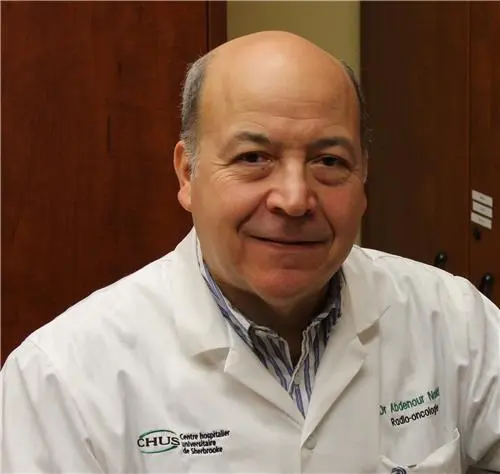357 - Testosterone Recovery post Androgen Depletion Therapy in Intermediate Risk Prostate Cancer Patients. Does a Higher Dose of Radiotherapy Impact on Survival? Long-Term Data from a Phase III Trial
Presenter(s)

A. Nabid1, N. Carrier2, E. Vigneault3, T. V. Nguyen4, P. Vavassis5, M. A. Brassard6, B. Bahoric7, R. Archambault8, F. Vincent9, R. Bettahar10, D. R. Wilke11, and L. Souhami12; 1CIUSSS de l'Estrie - CHUS, Sherbrooke, QC, Canada, 2Centre hospitalier universitaire de Sherbrooke, Sherbrooke, QC, Canada, 3CHU de Québec – Université Laval, Québec, QC, Canada, 4Centre Hospitalier de l'Université de Montréal, Montréal, QC, Canada, 5Maisonneuve-Rosemont Hospital, Montreal, QC, Canada, 6Centre Intégré Universitaire de Santé et de Services Sociaux du Saguenay-Lac-Saint-Jean, Chicoutimi, QC, Canada, 7Jewish General Hospital, Montreal, QC, Canada, 8Centre Intégré de Santé et de Services Sociaux de l'Outaouais, Gatineau, QC, Canada, 9Centre hospitalier regional de Trois-Rivieres, Trois-Rivieres, QC, Canada, 10CSSS Rimouski-Neigette, Rimouski, QC, Canada, 11Department of Radiation Oncology, QE2 Cancer Centre, Nova Scotia Health, Halifax, NS, Canada, 12McGill University Health Centre, Montreal, QC, Canada
Purpose/Objective(s):
Using data from a randomized Phase III trial in intermediate-risk prostate cancer (IRPC), we compared overall survival (OS) between two different doses of prostate radiotherapy (RT) by stratified patients (pts) with or without testosterone (T) recovery after androgen deprivation therapy (ADT).Materials/Methods:
From 10/2000 to 01/2008, 600 pts with IRPC were randomised to 6 months of ADT + RT 76 Gy or RT 70 Gy vs RT alone (76 Gy). The 400 pts treated with ADT were selected for this analysis. Serum T was measured at baseline, then regularly. We defined T recovery as a return of T to within the normal range value. We excluded 19 pts: 2 not receiving exactly 6 months of ADT, 5 not receiving 70 or 76 Gy, 12 no T available at baseline or during follow-up. Using log rank test, OS was compared between pts with or without T recovery and between pts receiving 70 or 76 Gy with or without T recovery. Multivariable analysis to predict OS included dose of RT, recovered T, age, Zubrod performance status, comorbidities, baseline PSA, Gleason score, and stage.Results:
381 pts receiving ADT and had proper T data available were retained for the analysis. 196 and 185 pts received 70 Gy or 76 Gy, respectively. The median age was 71 years (IQR 66-74). The two groups were well-balanced, except for a higher PSA >10 ng/ml in patients with 70 Gy (59.2% vs 46.5%, p=0.013). Over a period of 23 years, 4779 T measurements were available. With a median follow-up of 15.3 years, 291pts (76.4%) recovered T to normal level with no difference between 70 or 76 Gy cohorts (76.5% vs. 76.2%, p=0.94). The median time to T recovery was 1.64 (IQR 1.41-2.28) years, similar between 70 [1.6 (IQR: 1.4-2.1)] or 76 Gy [1.7 (IQR: 1.4-2.6)], p=0.084. A significant lower risk of death favoured pts recovering T [HR (95% CI) = 0.53 (0.39-0.73), p<0.001]. Considering the global hazard ratio (HR), no difference seen in OS between pts receiving 76 comparatively to 70 Gy [HR (95% CI) = 1.06 (0.80-1.39), p=0.70]. No significant difference seen in 10-year OS rates between pts receiving 70 or 76 Gy with T recovery [75% (68-82) vs. 80% (74-88), p=0.281] or not [60% (47-76) vs. 63% (50-79), p=0.882]. In multivariable analysis, dose of RT remained not significant for OS. T recovery [HR = 0.63 (0.45-0.87), p=0.006] plus Zubrod, age, COPD and baseline PSA played a significant role in OS. Of note, there was no difference in the rate of death from prostate cancer between pts recovering or not T (3.8% vs. 5.6%, p=0.46). Competing risk analysis confirms this finding [sHR = 0.60 (0.21-1.70), p=0.33].Conclusion:
In IRPC pts randomized to short-term ADT and either 70 or 76 Gy, T recovery to normal level is associated with a significant improvement in OS probably by protecting patients from the ill effects of a persistent castration. Delivering a higher dose of RT to the prostate had no impact on OS regardless of T status.